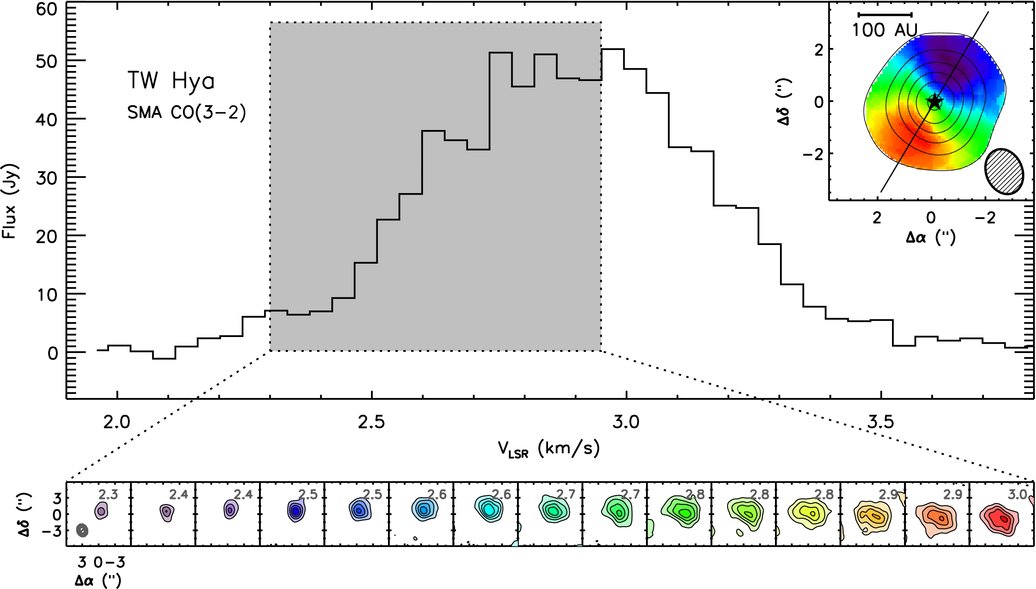TWHydraBand7 For CASA 3.3: Difference between revisions
No edit summary |
|||
| Line 7: | Line 7: | ||
TW Hya is a pre-main sequence classical T Tauri star at a distance of about 52+/-1 pc (Mamajek 2005,2010). TW Hya is the most studied member of the TW Hydra association (TWA) of low mass stars. From a wide variety of previous observations from the infrared to submillimeter, TW Hya is known to have a small optically thin hot inner disk to radii < 4 AU, and a larger cold dust disk out to about 200 AU (see for example introduction by Vacca & Sandell 2011, and references therein). Recent optical interferometry finds that TW Hya also contains a hot optically thick disk on even smaller sizescales of ~0.5 AU, and suggests that the optically thin disk could be due to gas clearing by a planet (Akeson et al. 2011). TW Hya is still accreting from its disk at a rate of about (4-20) x 10^-10 Msun/year and most recently its spectral type, mass, and age have been estimated at M2.5V, 0.4 Msun, and 3 Myr (Vacca & Sandell 2011). | TW Hya is a pre-main sequence classical T Tauri star at a distance of about 52+/-1 pc (Mamajek 2005,2010). TW Hya is the most studied member of the TW Hydra association (TWA) of low mass stars. From a wide variety of previous observations from the infrared to submillimeter, TW Hya is known to have a small optically thin hot inner disk to radii < 4 AU, and a larger cold dust disk out to about 200 AU (see for example introduction by Vacca & Sandell 2011, and references therein). Recent optical interferometry finds that TW Hya also contains a hot optically thick disk on even smaller sizescales of ~0.5 AU, and suggests that the optically thin disk could be due to gas clearing by a planet (Akeson et al. 2011). TW Hya is still accreting from its disk at a rate of about (4-20) x 10^-10 Msun/year and most recently its spectral type, mass, and age have been estimated at M2.5V, 0.4 Msun, and 3 Myr (Vacca & Sandell 2011). | ||
Millimeter and submillimeter observations of the continuum and spectral lines are particularly useful for tracing in the outer cold disk. Previous observations by the VLA at 7 mm (Wilner et al. 2000), ATCA at 3 mm (Wilner et al. 2003), and the SMA at 1.3, 0.87, and 0.45 mm (Qi et al. 2004, 2006, 2008 and Hughes et al. 2011) reveal Keplerian rotation in the disk and an inclination of about 7 degrees (i.e. almost face-on) | Millimeter and submillimeter observations of the continuum and spectral lines are particularly useful for tracing in the outer cold disk. Previous observations by the VLA at 7 mm (Wilner et al. 2000), ATCA at 3 mm (Wilner et al. 2003), and the SMA at 1.3, 0.87, and 0.45 mm (Qi et al. 2004, 2006, 2008 and Hughes et al. 2011) reveal Keplerian rotation in the disk and an inclination of about 7 degrees (i.e. almost face-on). Detailed studies of the dust continuum properties from this work suggests that there are centimeter sized particles within the cold protoplanetary disk. | ||
== How to Use This casaguide== | == How to Use This casaguide== | ||
Revision as of 18:50, 23 May 2011
Overview

TW Hya is a pre-main sequence classical T Tauri star at a distance of about 52+/-1 pc (Mamajek 2005,2010). TW Hya is the most studied member of the TW Hydra association (TWA) of low mass stars. From a wide variety of previous observations from the infrared to submillimeter, TW Hya is known to have a small optically thin hot inner disk to radii < 4 AU, and a larger cold dust disk out to about 200 AU (see for example introduction by Vacca & Sandell 2011, and references therein). Recent optical interferometry finds that TW Hya also contains a hot optically thick disk on even smaller sizescales of ~0.5 AU, and suggests that the optically thin disk could be due to gas clearing by a planet (Akeson et al. 2011). TW Hya is still accreting from its disk at a rate of about (4-20) x 10^-10 Msun/year and most recently its spectral type, mass, and age have been estimated at M2.5V, 0.4 Msun, and 3 Myr (Vacca & Sandell 2011).
Millimeter and submillimeter observations of the continuum and spectral lines are particularly useful for tracing in the outer cold disk. Previous observations by the VLA at 7 mm (Wilner et al. 2000), ATCA at 3 mm (Wilner et al. 2003), and the SMA at 1.3, 0.87, and 0.45 mm (Qi et al. 2004, 2006, 2008 and Hughes et al. 2011) reveal Keplerian rotation in the disk and an inclination of about 7 degrees (i.e. almost face-on). Detailed studies of the dust continuum properties from this work suggests that there are centimeter sized particles within the cold protoplanetary disk.
How to Use This casaguide
See EVLA_Spectral_Line_Calibration_IRC+10216#How_to_Use_This_casaguide page.